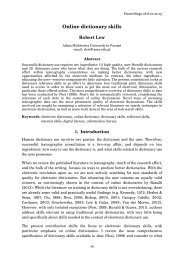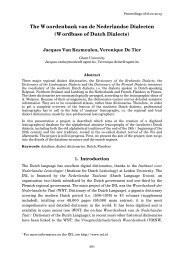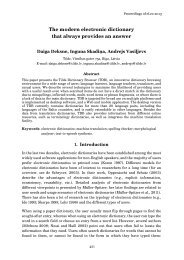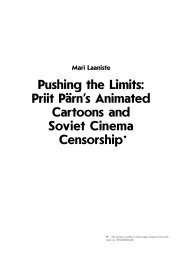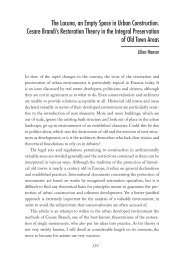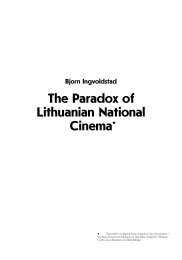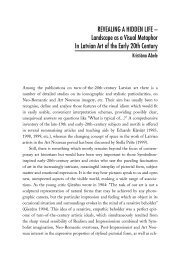LOCATIONS in INTERSEMIOTIC SPACE*
LOCATIONS in INTERSEMIOTIC SPACE*
LOCATIONS in INTERSEMIOTIC SPACE*
Create successful ePaper yourself
Turn your PDF publications into a flip-book with our unique Google optimized e-Paper software.
Peeter Torop<br />
the replacement of the study of regular connections with the study of occasional<br />
connections (Riffaterre 1994: 779–788). On the other hand, these casualties are<br />
exactly those dialogical events that base Mikhail Bakht<strong>in</strong>’s conception of culture,<br />
or on the grounds of which Umberto Eco has written, aside with decod<strong>in</strong>g <strong>in</strong><br />
culture, about extracod<strong>in</strong>g <strong>in</strong> its two manifestations – under- and overcod<strong>in</strong>g<br />
(Eco 1977: 136).<br />
One th<strong>in</strong>g is culture’s actual function<strong>in</strong>g and diversity <strong>in</strong> the reception proc-<br />
esses. Another th<strong>in</strong>g is an analyst’s <strong>in</strong>terest <strong>in</strong> the fate of a text as an artistic whole<br />
<strong>in</strong> culture, and <strong>in</strong> the comparison of the immanent peculiarity of a text with the<br />
text as a cultural text or the peculiarity of a text accepted <strong>in</strong>to culture. e accept-<br />
<strong>in</strong>g of a text <strong>in</strong>to culture and the creation of a text are both autocommunicative<br />
processes. e autocommunicativeness of culture is not much different from the<br />
autocommunicativeness of an <strong>in</strong>dividual creator. In neither case do we know with<br />
certa<strong>in</strong>ty if the case is about mnemonic autocommunication, i.e., about report<strong>in</strong>g<br />
the already known <strong>in</strong> another form or other sign systems, or with discover<strong>in</strong>g<br />
autocommunication, i.e., with the creation of novel correlations <strong>in</strong> what exists <strong>in</strong><br />
memory.<br />
Both autocommunicative processes are also <strong>in</strong>tegrative. An <strong>in</strong>dividual author<br />
<strong>in</strong>tegrates bluepr<strong>in</strong>ts <strong>in</strong>to a f<strong>in</strong>al text. Culture <strong>in</strong>tegrates metatexts <strong>in</strong>to a mental<br />
whole. In culture, from Yuri Lotman’s viewpo<strong>in</strong>t, we can dist<strong>in</strong>guish between two<br />
types of <strong>in</strong>tegration. One of them is connected with the development of meta-<br />
languages, i.e., with the meta- and autometadescriptions <strong>in</strong> culture. e other is<br />
connected with creolisation, i.e., with the fusion of the object- and metalanguag-<br />
es (Lotman 1978). us it is not enough to limit ourselves to a mental whole.<br />
Another parameter is needed still – the <strong>in</strong>tersemiotic one.<br />
e <strong>in</strong>tersemiosic aspect of culture is due to the partial overlap of signs and<br />
languages or sign systems of different arts – first, on the level of <strong>in</strong>dependent<br />
existence of these languages and texts created <strong>in</strong> them (e.g. film and theatre). e<br />
existence of a text as different simultaneous texts (e.g. novel, film, performance,<br />
picture) on the level of mental <strong>in</strong>terference is the second. e third: the level of<br />
projection to the propositional textual or <strong>in</strong>tertextual background. At the <strong>in</strong>-<br />
tersemiosic description of culture the recognisability of signs becomes important<br />
and also the fact that this recognisability takes place not only <strong>in</strong> the reception<br />
of <strong>in</strong>dividual holistic texts, but also <strong>in</strong> fragmentary reception processes. In the<br />
<strong>in</strong>tersemiosis of culture, mak<strong>in</strong>g sense and the hierarchisation of signs does not<br />
64



